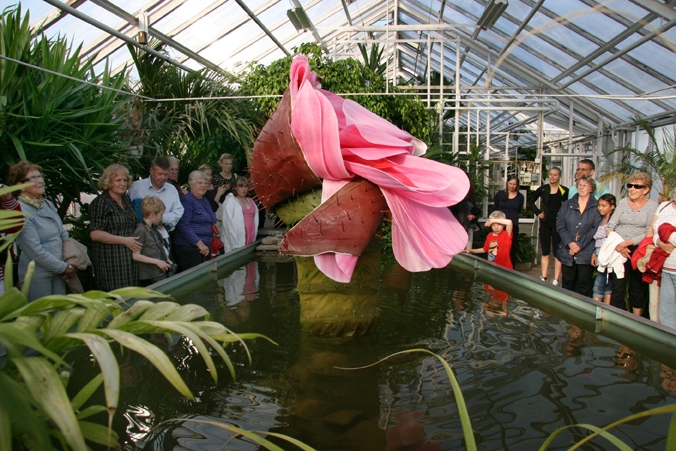First I saw the Giant Water Lily, Victoria amazonica, bloom: its spiky bud slowly breaking open so that long white petals could fall out like the tongues of prehistoric animals, as all the while the sweet smell of pineapple spread across the room. Then it was the Jan Lindblad Film Festival (2010), featuring immensely popular nature programmes made during the 1960s and 70s by Sweden’s answer to David Attenborough, who, unlike the Englishman, took his engagement with his subjects so far as to include wrestling with both tigers and anacondas. And then recently, when I saw documentation, by the same artist, of a giant (humansize) otter giving birth to three pups, my suspicion was confirmed: this was someone who is onto something special, and despite its naive appearance, her work has to be taken seriously.
Ingela Ihrman works within the horizon of the ‘wonders of nature’. Through her performances, rare plants from faraway places are brought to life, blooming in front of people’s eyes in greenhouses as well as exhibition spaces. There is the blooming of the snakelike cactus Queen of the Night, Selenicereus grandiflorus, which emits its vanilla fragrance at night, and another one with the dark red Giant Corpse Flower, Amorphophallus titanum, which comes with the smell of decomposing flesh. As the Latin name indicates, it does indeed look like a deformed phallus. Sometimes a botanist or gardener commentates on the performance, as they might have in the nineteenth century, when bloomings of this kind attracted large audiences – and as did the nature programmes broadcast on TV during the artist’s childhood.
Why is a young and apparently immensely thoughtful and talented person fabricating such odd, elaborate outfits, and then donning them in public (maybe in private too, who knows)? It is childish, playful, touching, imaginative and disturbing at the same time. It is possibly as far from cool – according to the measure of current barometers – as it gets, and very time-consuming as well. Ihrman’s works deal with mundane small-town pastimes and a deep-seated longing for faraway places. She works in a cultural context where the great outdoors is used for Sunday excursions and exercise, where it is enjoyed remotely on screens and studied in lexica, but where it also becomes a surface for emotional projection. She harnesses the great outdoors so that it might creep into other forms of existence, offering unlikely ways by which to transcend all kinds of limitations. And yet her work is not merely escapist.
In times of outsourcing and in which consumer relations override most other forms of human exchange, Ihrman’s return to hobbyism and craft, amateur theatre traditions and poetic absurdism is refreshing
On the animal side of Ihrman’s work there is the giant toad, which is struggling silently (and with great effort) to get through an obstacle race in a sports hall. The Russian Cave Goat is a rugged creature from the shores of the river Volga: in Ihrman’s reincarnation it is back in a real cave, bleating gently among a crowd of spectators. An early video features a human-size blackbird sitting on the roof of a house, singing its hopeful song of spring. There is also a video – particularly peculiar – showing what Jan Lindblad would have seen had he been inside the anaconda rather than outside it.
In times of outsourcing and in which consumer relations override most other forms of human exchange, Ihrman’s return to hobbyism and craft, amateur theatre traditions and poetic absurdism is refreshing. It certainly does not resemble anything else I have seen, and it makes me happy to know that this kind of ‘other world’ is even possible. When I try the modus of identification, of all her many creatures, I end up wanting to be the Stegocephalia from Bjuv – albeit temporarily. This prehistoric animal looks like a cross between a reptile and a character from The Muppet Show. More precisely it is a wearable reconstruction of an extinct amphibian named after the town in south Sweden where its fossil was found in a coalmine.
During the heyday of the Stegocephalia, this area was a shallow sea close to the equator. Such transformations of both the landscape and the climate are good reminders of the inescapable condition of change. Especially in this case, as 15 percent of the population in today’s Bjuv support the anti-immigrant, populist rightwing party Sweden Democrats, which champions nationalism and a chauvinistic cultural heritage based on twisted ideas of stability and homogeneity. It’s fitting then that in 2013 the artist donated the costume of the Stegocephalia from Bjuv to the local municipality for its citizens to wear at their discretion.
See here to read more by Maria Lind
This article was first published in the March 2015 issue.
